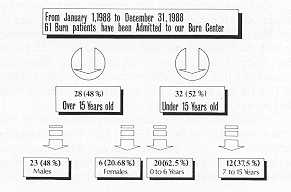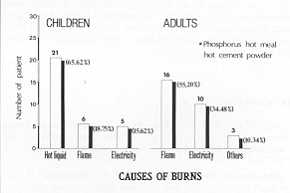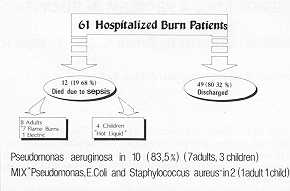Annals of the MBC - vol. 3 - n' 1 - March 1990 IS SEPSIS STILL A PROBLEM IN BURNS?Haberal M., Bayraktar U., OztOrk S., Oner I, Bilgin N. Hacettepe University Hospitals, Ankara, Turkey SUMMARY. From Ist January 1988 to 31st December 1988, 61 patients were admitted to our Bums Centre. The overall mortality was 19.67% 12 patients died and 49 patients were discharged. 8 (13.11%) adult patients died due to sepsis; in 7 of them, the bum cause was flame and in one electricity. 4 children died due to sepsis (bum cause hot liquid). Pseudomonas grew in 10 patients (83.33%), 7 adults and 3 children, and mixed bacteria in 2 patients (16.67%): in one adult (Pseudomonas, E. coli and Staph. coag+) and in one child (Pseudomonas, Proteus and Enterobacter). In this study, the great majority of evidence gathered by us revealed that sepsis is still an important problem among the patients who have presented at our Burns Centre. Introduction Today, the principle of burns
treatment is well known both in developed and developing countries. Many new facilities
are being established to treat burn patients. In spite of all these developments,
bacterial infection of burn wounds remains a major cause of morbidity and mortality in
thermally injured patients. Material and method From Ist January 1988 to 31st December 1988, 61 patients were admitted to our Burn Centre. 29 patients (48%) were over 15 years old and 32 patients (52%) were under 15 years old. Of these 32 children, 9 (28%) were females and 23 (72%) were males. 20 (62.5%) were between 0 and 6 years old. 12 (37.5%) were between 6 and 15 years old (mean 9.25 years) (Fig. 1). Of the 29 patients over 15 years old, 23 (79.32%) were males and 6 (20.68%) females with the mean age of 34 years (15 to 71 years). The causes of the bums in children were hot liquid in 21 (65.62%), flame in 6 (18.75%) and electricity in 5 (15.62%). The causes, of the burns in the adults were flame in 16 (55.20%), electricity in 10 (34.48%) and others (phosphorus, hot meal and hot cement powder) in 3 (10 .34%) (Fig. 2). Modified Parkland Formula, silver sulphadiazine, Betadine solution and silver incorporated amniotic membrane were used as treatment agents and systemic antibiotics were administered according to wound cultures.
Results The overall mortality was 19.67%: 12
patients died and 49 patients were discharged. 8 (13.11%) adult patients died due to
sepsis; in 7 of these, the burn cause was flame burn and in one electricity. In contrast,
4 children died due to sepsis, burn cause being hot liquid. Discussion Infection still continues to be
frequent following thermal injury despite the use of topical and systemic antimicrobical
therapy, in our units being especially due to Pseudomonas aeruginosa infection (3, 4).
Unfortunately, we are not able to perform
early excision which decreases hospitalization time, morbidity and mortality. Another
important factor decreasing mortality is the number of hospitalized patients and patient
care. In recent years, the number of hospitalized patients has decreased and parallel to
this, the mortality rate dropped, although Pseudomonas infection remained the main cause
of mortality. RÉSUMÉ. Les Auteurs rapportent 61 cas de patients hospitalisés chez leur Centre des Brûlés pendant tout l'année 1988, dont 12 sont morts et 49 été renvoyés à la maison (taux de mortalité: 19,67%). 8 patients adultes (l 3J 1 %) sont morts d'infection septique, dont 7 à la suite de brûlure par flamme et un de brûlure électrique. 4 enfants sont morts d'infection septique à la suite de brûlure par liquide chaud. Le Pseudomonas a été trouvé chez 10 patients (83,33%), dont 7 adultes et 3 enfants, et des bactéries mixtes chez 2 patients (16,67%), dont un adulte (Pseudomonas, E. coli et Staph. Coag+) et un enfant (Pseudornonas, Proteus et Enterobacter). Les Auteurs soulignent que la grande majorité des résultats indiquent que l'infection septique représente toujours un important problème parmi les patients qui se sont présentés chez leur Centre. BIBLIOGRAPHY
|


